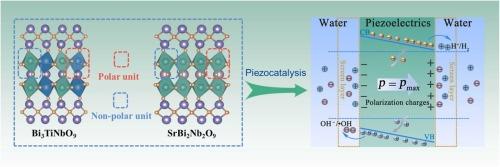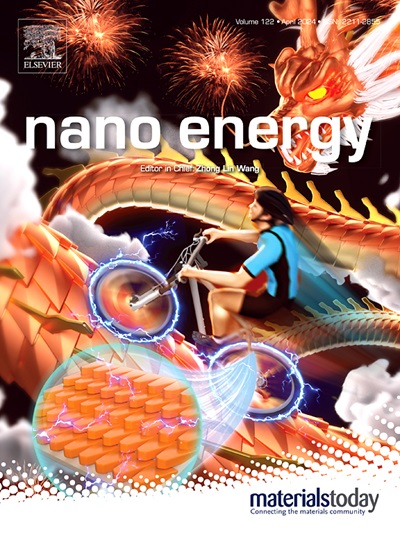识别同构层状过氧化物中的极性和非极性八面体单元,实现高效压电催化 H2 演化
IF 16.8
1区 材料科学
Q1 CHEMISTRY, PHYSICAL
引用次数: 0
摘要
机械能驱动分水以实现 H2 演化是实现碳中和的可行策略之一,但迄今为止,高效压电催化剂的开发和对压电催化机理的深入理解仍存在许多不足。在此,我们开发了两种同构层状过氧化物--Bi3TiNbO9 和 SrBi2Nb2O9,它们由[Bi2O2]2+层和沿 c 轴的[BiTiNbO7]2-或[SrNb2O7]2-层构建而成,可作为 H2 挥发的压电催化剂。在以葡萄糖为牺牲剂的条件下,Bi3TiNbO9 的压电催化产生 H2 的速率为 1025.5 µmol g-1 h-1,而 SrBi2Nb2O9 的 H2 进化速率为 586.1 µmol g-1 h-1。对八面体畸变指数和键角方差等微观结构信息的实验分析和理论计算表明,与 NbO6 八面体相比,TiO6 八面体具有更高的畸变程度,这使得 Bi3TiNbO9 在压电性、极性和极性变化程度、载流子浓度和分离效率方面具有更优异的性能。深入分析发现,在拉伸或压缩应变下,Bi3TiNbO9 的 a 轴发生了显著变化,而 b 轴的变化相对较小,这是因为包晶层对应力的响应比 [Bi2O2]2+ 层更明显。有趣的是,研究发现在层状包晶的构建单元中,只有特定位置的八面体表现出有助于压电催化的偶极矩场,而其他八面体的影响可以忽略。最终,对压电催化过程进行了合理的分析和解释。这项工作为在准确区分固有极性单元的基础上设计高性能压电催化剂提供了前瞻性视角。本文章由计算机程序翻译,如有差异,请以英文原文为准。

Identifying polar and non-polar octahedron units in isomorphic layered perovskites towards efficient piezocatalytic H2 evolution
Mechanical energy-driven water splitting for H2 evolution is one of the promising strategies to achieve carbon neutrality, but so far the development of efficacious piezocatalysts and the in-depth understanding of the piezocatalytic mechanism still have many deficiencies. Here, two isomorphic layered perovskites, Bi3TiNbO9 and SrBi2Nb2O9 constructed by [Bi2O2]2+ layers and [BiTiNbO7]2− or [SrNb2O7]2− layers along the c-axis, are developed as H2-evoluting piezocatalysts. Bi3TiNbO9 exhibits a piezocatalytic H2 production rate of 1025.5 µmol g−1 h−1 with glucose as the sacrificial agent, while the H2 evolution rate of SrBi2Nb2O9 is 586.1 µmol g−1 h−1, respectively. The experimental analyses and theoretical calculations on microstructural information, such as octahedron distortion index and bond angle variance, demonstrate that TiO6 octahedra have a higher degree of distortion compared to NbO6 octahedra, which results in more excellent properties in piezoelectricity, polarity and degree of polarity change, carrier concentration and separation efficiency of Bi3TiNbO9. In-depth analysis reveals that, under tensile or compressive strain, the a-axis alters significantly and the b-axis underwent a relatively minor change in Bi3TiNbO9 due to the fact that perovskite layers show more pronounced response to the stress than the [Bi2O2]2+ layers. Interestingly, it is found that in the building units of layered perovskites, only the octahedra at specific positions exhibit dipole moment field that contributes to piezocatalysis, while the effect of others can be neglected. Ultimately, a reasonable analysis and explanation of the piezocatalytic process is carried out. This work provides a forward-looking perspective into the design of high-performance piezocatalysts on the basis of accurately distinguishing intrinsic polar units.
求助全文
通过发布文献求助,成功后即可免费获取论文全文。
去求助
来源期刊

Nano Energy
CHEMISTRY, PHYSICAL-NANOSCIENCE & NANOTECHNOLOGY
CiteScore
30.30
自引率
7.40%
发文量
1207
审稿时长
23 days
期刊介绍:
Nano Energy is a multidisciplinary, rapid-publication forum of original peer-reviewed contributions on the science and engineering of nanomaterials and nanodevices used in all forms of energy harvesting, conversion, storage, utilization and policy. Through its mixture of articles, reviews, communications, research news, and information on key developments, Nano Energy provides a comprehensive coverage of this exciting and dynamic field which joins nanoscience and nanotechnology with energy science. The journal is relevant to all those who are interested in nanomaterials solutions to the energy problem.
Nano Energy publishes original experimental and theoretical research on all aspects of energy-related research which utilizes nanomaterials and nanotechnology. Manuscripts of four types are considered: review articles which inform readers of the latest research and advances in energy science; rapid communications which feature exciting research breakthroughs in the field; full-length articles which report comprehensive research developments; and news and opinions which comment on topical issues or express views on the developments in related fields.
 求助内容:
求助内容: 应助结果提醒方式:
应助结果提醒方式:


